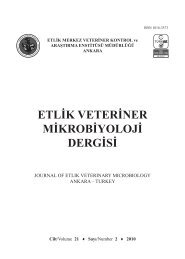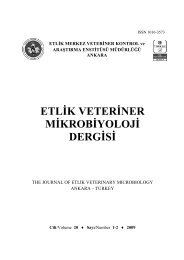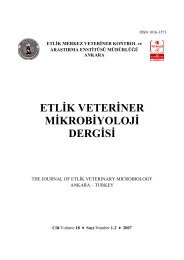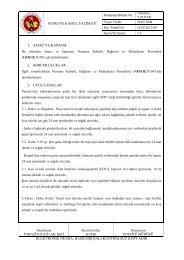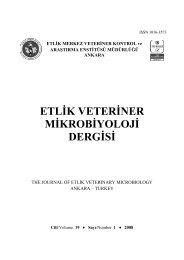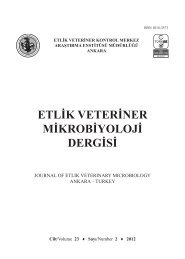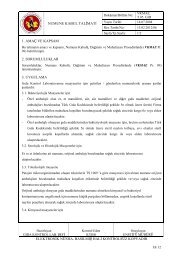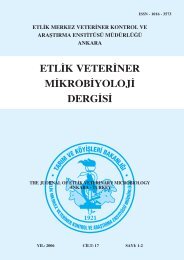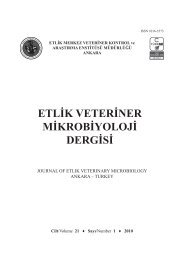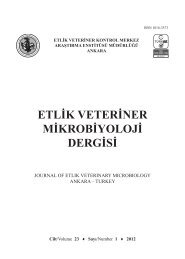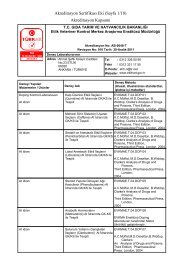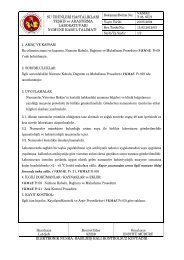etlik veteriner mikrobiyoloji dergisi - veteriner kontrol merkez ...
etlik veteriner mikrobiyoloji dergisi - veteriner kontrol merkez ...
etlik veteriner mikrobiyoloji dergisi - veteriner kontrol merkez ...
Create successful ePaper yourself
Turn your PDF publications into a flip-book with our unique Google optimized e-Paper software.
Albayrak ve ark. Etlik Vet Mikrobiyol Derg, 22, 49-53, 2011 51<br />
Taq DNA Polymerase (0.5 U/ml). Template DNA<br />
(5 µl at 100 ng/µl) was added to the aliquot (45 µl)<br />
of mastermix. Thermocycling conditions included<br />
an initial denaturation at 95°C (15 min), followed<br />
by 37 cycles at 94°C (50 s), 45.6-56.5°C (50 s) and<br />
72°C (60 s) with a final 10 min extension at 72 °C<br />
using a PTC 100 machine (MJ Research, USA).<br />
Amplified products were separated in a 1%<br />
agarose gel and visualised under ultraviolet illumination<br />
following ethidium bromide staining. All<br />
successfully amplified products were purified using<br />
the QIAquick® Gel Extraction Kit (Qiagen GmbH,<br />
Hilden, Germany). Sequencing reactions on purified<br />
PCR products included primer pairs used for<br />
initial amplification (at 0.5 initial concentration),<br />
and the ABI PRISM® BigDye® Terminator v3.1<br />
Cycle Sequencing Kit (Applied Biosystems, Foster<br />
City, USA) was used according to the manufacturer’s<br />
instruction. Sequenced products were cleaned<br />
with DyeEx 2.0 Nucleospin nucleotide removal kit<br />
(Qiagen GmbH, Hilden, Germany). Automated fluorescence<br />
sequencing was performed with an ABI<br />
PRISM® 310 Genetic Analyser (Applied Biosystems,<br />
Foster City, USA).<br />
Sequence Analysis: The sequences were edited<br />
and aligned using CLC Main Workbench software<br />
(22). Multiple sequence alignments were generated<br />
using CLC Main Workbench program (22). Cytochrome<br />
b gene haplotype consensus sequences were<br />
generated for each species (811 bases) covering the<br />
142-952 base nucleotide region of the cytochrome b<br />
gene, with an out group (GenBank Accession number<br />
is EU751000) also aligned. Additional bat species<br />
sequences (GU817369, GU817368, EU153108,<br />
AF376830, AF376841, AF376840) were obtained<br />
from the National Centre for Biotechnology Information<br />
(NCBI) and used for comparison. Phylogenetical<br />
tree was built by Neighbor-Joining method<br />
(Fig. 2). Reliability of clades was checked with<br />
bootstrap analysis with 1000 replications (18).<br />
Figure 2. Phylogenetic relationships of three different bat species. Y8 and Y16 are used for additional data. Bat species<br />
sequences (GU817369, GU817368, EU153108, AF376830, AF376841, AF376840) were obtained from NCBI<br />
and used for comparison.<br />
Findings<br />
Cytochrome b sequences were obtained from three<br />
species, the sequence length 811 bases. These sequences<br />
have been deposited to GenBank with<br />
the accession numbers HM011051, HM011052<br />
and HM011053. A sample of Eptesicus serotinus<br />
(EU751000) from Azerbaijan (27) was included in<br />
the analysis as an outgroup. The species consensus<br />
sequences (811bases) were built using nucleotide<br />
region of the cytochrome b gene. This consensus<br />
demonstrated that they aligned across 811 bases,



